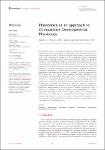Phenomics as an approach to Comparative Developmental Physiology
| dc.contributor.author | McCoy, JCS | |
| dc.contributor.author | Spicer, JI | |
| dc.contributor.author | Ibbini, Z | |
| dc.contributor.author | Tills, O | |
| dc.date.accessioned | 2023-11-28T13:29:59Z | |
| dc.date.available | 2023-11-28T13:29:59Z | |
| dc.date.issued | 2023-08-14 | |
| dc.identifier.issn | 1664-042X | |
| dc.identifier.issn | 1664-042X | |
| dc.identifier.other | ARTN 1229500 | |
| dc.identifier.uri | https://pearl.plymouth.ac.uk/handle/10026.1/21748 | |
| dc.description.abstract |
The dynamic nature of developing organisms and how they function presents both opportunity and challenge to researchers, with significant advances in understanding possible by adopting innovative approaches to their empirical study. The information content of the phenotype during organismal development is arguably greater than at any other life stage, incorporating change at a broad range of temporal, spatial and functional scales and is of broad relevance to a plethora of research questions. Yet, effectively measuring organismal development, and the ontogeny of physiological regulations and functions, and their responses to the environment, remains a significant challenge. “Phenomics”, a global approach to the acquisition of phenotypic data at the scale of the whole organism, is uniquely suited as an approach. In this perspective, we explore the synergies between phenomics and Comparative Developmental Physiology (CDP), a discipline of increasing relevance to understanding sensitivity to drivers of global change. We then identify how organismal development itself provides an excellent model for pushing the boundaries of phenomics, given its inherent complexity, comparably smaller size, relative to adult stages, and the applicability of embryonic development to a broad suite of research questions using a diversity of species. Collection, analysis and interpretation of whole organismal phenotypic data are the largest obstacle to capitalising on phenomics for advancing our understanding of biological systems. We suggest that phenomics within the context of developing organismal form and function could provide an effective scaffold for addressing grand challenges in CDP and phenomics. | |
| dc.format.extent | 1229500- | |
| dc.format.medium | Electronic-eCollection | |
| dc.language | eng | |
| dc.publisher | Frontiers Media SA | |
| dc.subject | phenomics | |
| dc.subject | development | |
| dc.subject | bioimaging | |
| dc.subject | embryonic development | |
| dc.subject | Comparative Developmental Physiology | |
| dc.title | Phenomics as an approach to Comparative Developmental Physiology | |
| dc.type | journal-article | |
| dc.type | Article | |
| plymouth.author-url | https://www.ncbi.nlm.nih.gov/pubmed/37645563 | |
| plymouth.volume | 14 | |
| plymouth.publication-status | Published online | |
| plymouth.journal | Frontiers in Physiology | |
| dc.identifier.doi | 10.3389/fphys.2023.1229500 | |
| plymouth.organisational-group | |Plymouth | |
| plymouth.organisational-group | |Plymouth|Research Groups | |
| plymouth.organisational-group | |Plymouth|Faculty of Science and Engineering | |
| plymouth.organisational-group | |Plymouth|Faculty of Science and Engineering|School of Biological and Marine Sciences | |
| plymouth.organisational-group | |Plymouth|Research Groups|Marine Institute | |
| plymouth.organisational-group | |Plymouth|REF 2021 Researchers by UoA | |
| plymouth.organisational-group | |Plymouth|Users by role | |
| plymouth.organisational-group | |Plymouth|Users by role|Academics | |
| plymouth.organisational-group | |Plymouth|REF 2021 Researchers by UoA|UoA07 Earth Systems and Environmental Sciences | |
| plymouth.organisational-group | |Plymouth|Users by role|Researchers in ResearchFish submission | |
| plymouth.organisational-group | |Plymouth|REF 2028 Researchers by UoA | |
| plymouth.organisational-group | |Plymouth|REF 2028 Researchers by UoA|UoA07 Earth Systems and Environmental Sciences | |
| dc.publisher.place | Switzerland | |
| dcterms.dateAccepted | 2023-07-24 | |
| dc.date.updated | 2023-11-28T13:29:49Z | |
| dc.rights.embargodate | 2023-12-6 | |
| dc.identifier.eissn | 1664-042X | |
| rioxxterms.versionofrecord | 10.3389/fphys.2023.1229500 |


